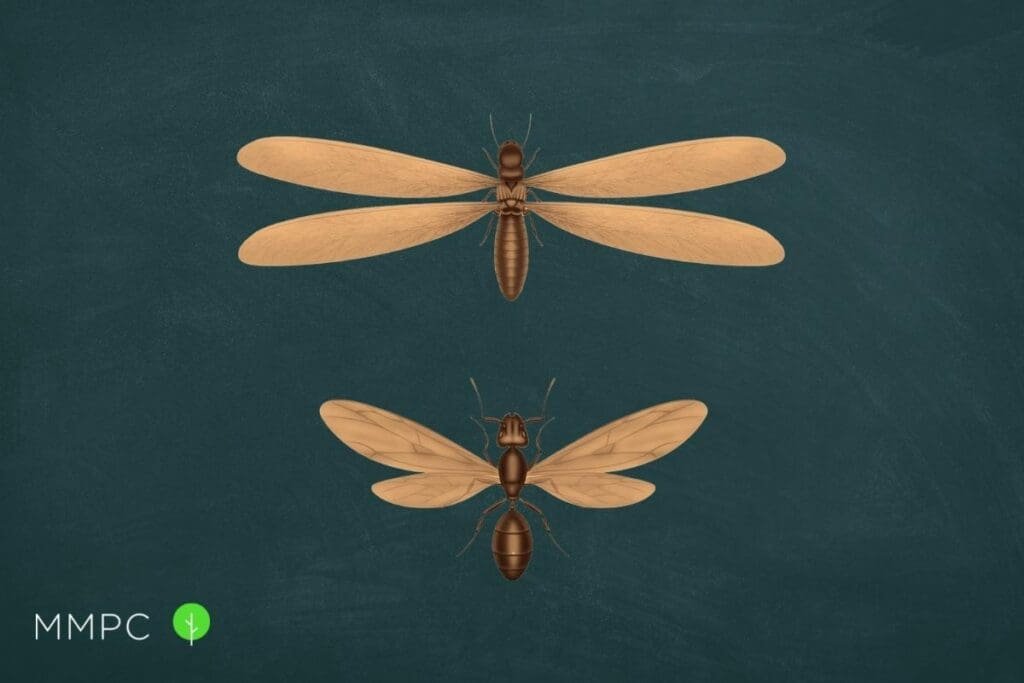
Winged termite swarmers can be spotted in and around your home when they’re looking for new locations to mate and start new colonies.
Finding discarded wings or winged insects in your home—especially in the early spring when temperatures outside begin to reach 70 °F—can serve as a warning sign of a termite infestation.
But because of their size and appearance, termite swarmers are often confused for flying ants, which is a sign of a completely different type of pest problem. So how can you tell them apart?
What Are Termite Swarmers?
Termite swarmers, also called “alates“, are the reproductive caste of a termite colony. Their only purpose is to emerge in large swarms during the spring to mate and establish new colonies.
Unlike termite workers and soldiers, swarmers can be easily identified by their two sets of long, transparent wings that extend past the length of their abdomen.
After finding a mate, termite swarmers shed their wings to become kings and queens of new termite colonies. This behavior often results in homeowners finding small piles of discarded insect wings near windowsills and doorways.
Appearance of Flying Ants vs. Termites

Termite Swarmers
Termite swarmers usually have dark brown-colored bodies ranging from 3/8–1 inch in length, depending on the species.
The main features to pay attention to in order to differentiate termites from flying ants are:
- Straight antennae
- Broad waists
- Equally-sized front and hind wings
Termites have “straight” antennae composed of many small, bead-like segments. They’re not always rigidly straight—they can also curve and twist—but they aren’t bent in an elbow-shape like ant antennae are.
Unlike flying ants, termite swarmers also have wide waists, giving their bodies a somewhat uniform thickness from their head to their abdomen. On the other hand, flying ants have narrow, pinched waists that clearly separate their bodies into 3 segments.
If you look closely, you can also tell termite swarmers apart from ants by their wings. Termite swarmers have 2 sets of wings, and each set of wings is equal in shape and size. Flying ants also have two sets of wings, but their front wings are much larger than their hind wings.

Flying Ants
Flying ants, also known as winged ants, are not a unique species of ant. Like termite swarmers, flying ants are just the reproductive members of an ant colony whose purpose is to find mates and establish new colonies.
To determine if the specimen you found is a flying ant, look for these characteristics:
- Bent or elbowed antennae
- Pinched waist
- Longer front wings and shorter hind wings
Flying ants are also dark colored—usually reddish-brown or black. Winged ants are also similar in size to termite swarmers, growing to around 3/4 inch in length.
The main way to tell them apart from termites is by looking for their pinched waist that separates the thorax from the abdomen. Ants have a tiny structure called a petiole, which connects the thorax and abdomen.
Because of their pinched waist, you can see 3 clearly separate body segments (head, thorax, and abdomen) in ants, whereas termites’ thoraxes are broadly joined to the abdomen, making it look as though they only have 2 distinguishable body segments.
Besides the waist, you can also look at the antennae and wings to confirm that it’s a flying ant, not a termite.
On their heads, ants have antennae that are divided into two main parts (called the scape and the club) which are bent in an elbow shape.
On their backs, flying ants have two sets of tinted brown wings. The set of wings in the front are noticeably larger than the set of wings in the rear. Like termites, flying ants also shed their wings after mating.
Are Flying Ants and Termite Swarmers Dangerous?
Termite swarmers themselves are not dangerous. They do not bite, sting, or transmit diseases to humans.
Flying ants are also not considered dangerous. Although they are capable of biting (some species can also sting), they are not aggressive towards humans and will only do so if threatened.
But you should still treat them as serious pest issues, since both can be signs of a possible termite or ant infestation nearby.
About MMPC
MMPC is an award-winning, eco-friendly pest control company based in New York City. We have over 25 years of experience as one of the top termite and ant control experts in the Tri-State Area.
If you are still having trouble determining which types of pests you are dealing with, MMPC offers a Free Pest ID Service. You can upload photos of any pest specimens that you’ve found and we will provide you with free identification and recommendations for treatment.
Termite infestations are not to be ignored, as these pests are capable of causing significant damage to the structure of your home. MMPC is here to help you determine if you have a termite issue and how to fix it.
Contact us today for pest identification, termite inspections, or other pest control services in New York City.
